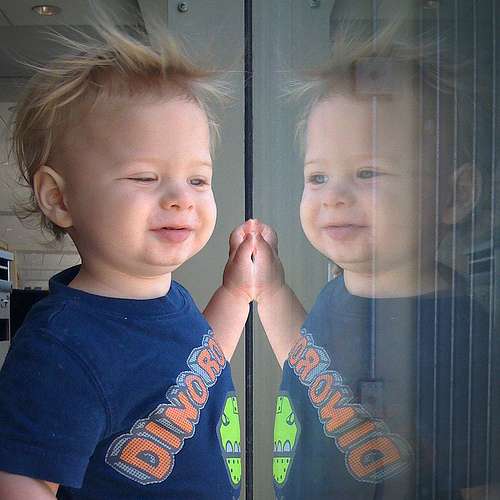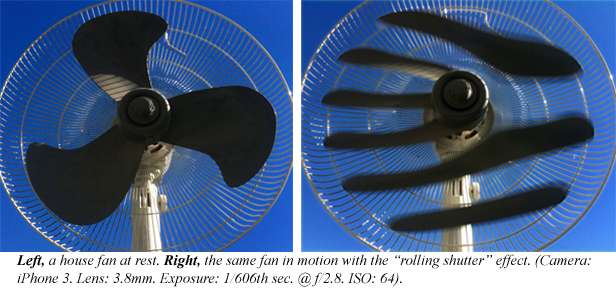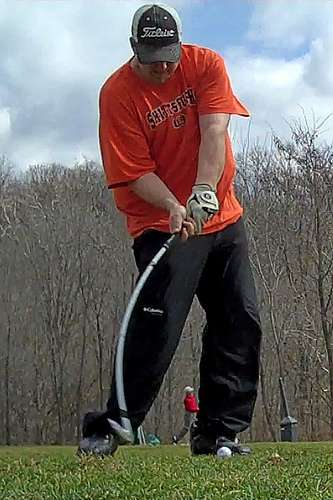It looks like you're using an Ad Blocker.
Please white-list or disable AboveTopSecret.com in your ad-blocking tool.
Thank you.
Some features of ATS will be disabled while you continue to use an ad-blocker.
share:
...Plane losing its prop
...Helicopter flying with motionless blades
This very odd effect can be seen using digital still and video cameras that have a CMOS sensor and is known to be one of the "rolling shutter effect".
Rolling shutter (also known as line scan) is a method of image acquisition in which each frame is recorded not from a snapshot of a single point in time, but rather by scanning across the frame either vertically or horizontally. In other words, not all parts of the image are recorded at exactly the same time, even though the whole frame is displayed at the same time during playback. This in contrast with global shutter in which the entire frame is exposed for the same time window.
This produces predictable distortions of fast-moving objects or when the sensor captures rapid flashes of light.
SOURCE
Some stills:

An iPhone's CMOS camera has no shutter, and reads the pixel values off in rows rather than all at once. In this photo the propeller spins about 5 times while the photo is taken, producing a strange effect.
Credits: Flickr's user sorenragsdale.

Look closely at the eyes of user's son in both original and reflection image
Credits: Flickr's user Douglasspics.
I have never heard of this until now, and at the moment, am still not entirely understanding what is causing this, but I like it.
That helicopter video is awesome. I just did a quick search on CMOS, I think I found the wrong results. What does that stand for? Mainly, for right now, I just want to know if I can do this on my camera. I doubt I can, but would be nice. I could have some fun with that setting.
That helicopter video is awesome. I just did a quick search on CMOS, I think I found the wrong results. What does that stand for? Mainly, for right now, I just want to know if I can do this on my camera. I doubt I can, but would be nice. I could have some fun with that setting.
I love these, Gizmodo had a cool article on it a while ago:
www.gizmodo.com.au...
Reminds me of surrealist art
www.gizmodo.com.au...
Reminds me of surrealist art
edit on 18-4-2011 by Hawking because: (no reason given)
reply to post by BrokenCircles
The camera "scans" the image from top to bottom or left to right, so something moving very fast, like propellers, seem to be in multiple places at once.
The camera "scans" the image from top to bottom or left to right, so something moving very fast, like propellers, seem to be in multiple places at once.
reply to post by Hawking
Yeah it's pretty amazing, and really our eyes do the same thing just at such higher rates that we barely notice it, our brain is fantastic at interpolation.
Now if you can convince people to take this into account instead of crying "alien tech" every time they catch something weird on camera we'll be golden.
Yeah it's pretty amazing, and really our eyes do the same thing just at such higher rates that we barely notice it, our brain is fantastic at interpolation.
Now if you can convince people to take this into account instead of crying "alien tech" every time they catch something weird on camera we'll be golden.
Yeah I love that helicopter video.
Originally posted by BrokenCircles
That helicopter video is awesome. I just did a quick search on CMOS, I think I found the wrong results. What does that stand for? Mainly, for right now, I just want to know if I can do this on my camera. I doubt I can, but would be nice. I could have some fun with that setting.
The propeller video looks like an invading fleet of boomerang shaped UFOs.
And of course the famous "rod" phenomenon is an artifact of shutter speed distorting the images of flying creatures like birds, bats, and bugs. I was going to post the monsterquest investigation of rods but the video has been removed from youtube.
Edit to add: I found another source on youtube for the "rod" camera effect:
Here also the camera doesn't always tell the truth. Well, the high speed camera does, but almost nobody has those.
Heres the CMOS info:
Image sensor
CCDs and CMOS sensors each have advantages and disadvantages. That link describes some of them.
An image sensor is a device that converts an optical image to an electric signal. It is used mostly in digital cameras and other imaging devices. Early sensors were video camera tubes but a modern one is typically a charge-coupled device (CCD) or a complementary metal–oxide–semiconductor (CMOS) active pixel sensor.
edit on
18-4-2011 by Arbitrageur because: added video
That is indeed a great comparison video which I haven't seen before!
Originally posted by elevenaugust
Thanks Arbitrageur for the info!
A great comparison of how the CMOS and CCD react in some conditions:
Thanks for sharing it!
I guess we better stick with CCDs for filming from a moving vehicle, but CMOS has become quite popular.
And I'll bet a lot of camera owners don't even know which type of image sensor they have!
reply to post by elevenaugust
The end of the house fan video is pretty cool, when it is slowing down.
I am still having troubles. I understand what is going on. I can see what is happening and why(kinda), but not on the helicopter vid in the OP.
The end of the house fan video is pretty cool, when it is slowing down.
I am still having troubles. I understand what is going on. I can see what is happening and why(kinda), but not on the helicopter vid in the OP.
That's the easiest one of all to understand, the other effects are more complex to explain.
Originally posted by BrokenCircles
I can see what is happening and why(kinda), but not on the helicopter vid in the OP.
The helicopter has 5 blades if I recall. so every 1/5 rotation the blades are in the same position. So when the shutter opens, the blades have rotated either 1/5, 2/5, 3/5...etc or some multiple of a fifth of a rotation so the blades are in the same position each time the shutter opens. That's why the rotor appears stationary.
If you ever set timing on a car, that's how the strobe works when you set the timing, but in that case you have a flashing strobe light instead of an opening shutter. But it produces the same effect, it "freezes" the timing wheel.
This is both amazing and humiliating...
Amazing because I've never seen anything like this before especially the helicopter footage which blew me away.
Humiliating because no matter how many times I've read what causes this effect I still can't get my head around it! lol.
Amazing because I've never seen anything like this before especially the helicopter footage which blew me away.
Humiliating because no matter how many times I've read what causes this effect I still can't get my head around it! lol.
I doubt it. Just an accident they happened to match I suspect.
Originally posted by BrokenCircles
reply to post by Arbitrageur
So I assume that the timing of this setting on the camera be adjusted?
You can see slight variations in the sync. When the helicopter turns it looks like the blades might slow down just a hair and you can see some small movement, and when it stops turning the blades speed back up and match the shutter again.
edit on 18-4-2011 by Arbitrageur because:
clarification
Okay so picture this, take a digital clock after a power failure and it is blinking 12:00. Now if you blink your eyes at the same rate the 12:00
blinks, then it will appear as if the 12:00 was stationary and never blinked. It's not until you stop blinking that you see the 12:00 blinking.
I hope that is a good analogy.
I hope that is a good analogy.
This ones pretty cool:
Great little video showing how/why it happens:
ALS
Great little video showing how/why it happens:
ALS
edit on 18-4-2011 by ALOSTSOUL because: (no reason given)
reply to post by Arbitrageur
It even seemed like they were slightly moving back the opposite direction at one point, but only for a couple seconds. I understand how that happens, but that's caused from an intermittent shutter right?(open, close, open, close, etc.etc.)
The reason I said I didn't understand is because of the other explanations stating that it is scanning(left to right or top to bottom). That is different from the helicopter, and to me it seems like its a different setting, or the same setting adjusted differently.
Obviously, I don't know much about camera settings, but it is something that I have been wanting to get a better grasp on. For example, I've had my camera for years. I was never able to get a good, zoomed in pic of the moon at night. Last month, I finally did. It wasn't hard, but a few different settings have to be adjusted just right.
It even seemed like they were slightly moving back the opposite direction at one point, but only for a couple seconds. I understand how that happens, but that's caused from an intermittent shutter right?(open, close, open, close, etc.etc.)
The reason I said I didn't understand is because of the other explanations stating that it is scanning(left to right or top to bottom). That is different from the helicopter, and to me it seems like its a different setting, or the same setting adjusted differently.
Obviously, I don't know much about camera settings, but it is something that I have been wanting to get a better grasp on. For example, I've had my camera for years. I was never able to get a good, zoomed in pic of the moon at night. Last month, I finally did. It wasn't hard, but a few different settings have to be adjusted just right.
Yes you're right.
Originally posted by BrokenCircles
The reason I said I didn't understand is because of the other explanations stating that it is scanning(left to right or top to bottom). That is different from the helicopter, and to me it seems like its a different setting, or the same setting adjusted differently.
For me at least, the scanning effect is harder to explain/understand compared to the effect on the helicopter video which is just a coincidence of the shutter speed matching the rotational speed of the rotor in some kind of 1/5 rotation increment.
And there's nothing unusual about the shape of the helicopter. The scanning effects distort the shapes so you get propeller artifacts that look like a boomerang instead of a propeller.
Another similar effect like the helicopter effect you can watch for, are movies made on the roads or highway where you can see the wheels of cars appear to stop turning, like at 1:11 in this video:
It especially looks odd when the sync is a little off and it looks like the wheels are turning backwards, but that video may not be a good example of that because sometimes the wheels actually DO turn backwards, but you can see that effect even when the wheels are turning forward, like around 1:20 and 2:19 in that video.
Thanks, that's a great explanation, and they don't even have to say a word, they show it graphically!
Originally posted by ALOSTSOUL
Great little video showing how/why it happens:
I knew that's what was happening, but the visual helps!
reply to post by Arbitrageur
Well they do say a picture tells a thousand word so a Youtube video tells...........
ALS
Well they do say a picture tells a thousand word so a Youtube video tells...........
ALS
new topics
-
DOJ Special Counsel Robert HUR Says JOE BIDEN Can Be ARRESTED After Jan 20th 2025.
Above Politics: 1 hours ago -
More Proof of Lawfare
US Political Madness: 8 hours ago -
I thought Trump was the existential threat?
World War Three: 10 hours ago -
Interesting Video-UFO?
Aliens and UFOs: 10 hours ago -
Joe Biden Dabs Away Tears at Farewell White House Dinner
Politicians & People: 11 hours ago
top topics
-
I thought Trump was the existential threat?
World War Three: 10 hours ago, 19 flags -
More Proof of Lawfare
US Political Madness: 8 hours ago, 18 flags -
Joe Biden Dabs Away Tears at Farewell White House Dinner
Politicians & People: 11 hours ago, 9 flags -
Interesting Video-UFO?
Aliens and UFOs: 10 hours ago, 6 flags -
DOJ Special Counsel Robert HUR Says JOE BIDEN Can Be ARRESTED After Jan 20th 2025.
Above Politics: 1 hours ago, 4 flags
active topics
-
The Acronym Game .. Pt.4
General Chit Chat • 985 • : FullHeathen -
I thought Trump was the existential threat?
World War Three • 50 • : ADVISOR -
Merry-Go-Round Ride
Short Stories • 9 • : randomuser2034 -
More Proof of Lawfare
US Political Madness • 26 • : ElitePlebeian2 -
DOJ Special Counsel Robert HUR Says JOE BIDEN Can Be ARRESTED After Jan 20th 2025.
Above Politics • 6 • : WeMustCare -
Joe Biden Dabs Away Tears at Farewell White House Dinner
Politicians & People • 23 • : xuenchen -
On Nov. 5th 2024 - AMERICANS Prevented the Complete Destruction of America from Within.
2024 Elections • 159 • : WeMustCare -
What if this is true?
2024 Elections • 30 • : chr0naut -
Petition Calling for General Election at 564,016 and rising Fast
Political Issues • 88 • : Freeborn -
Well, here we go red lines crossed Biden gives the go ahead to use long range missiles
World War Three • 360 • : Freeborn


